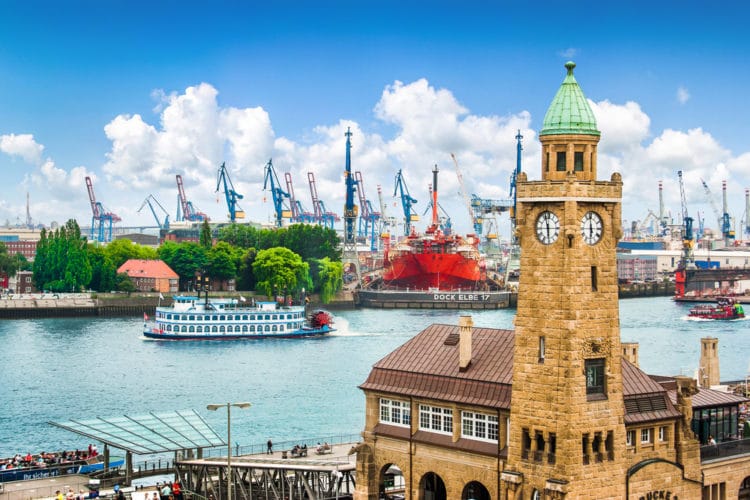Hamburg, a city-port and one of Germany’s 16 federal states, stretches along the banks of the full-flowing Elbe River in northern Germany. Here, in the industrial capital of the FRG, the past and present, romance and pragmatism, free spirit, and stern character coexist. This place attracts with its astonishingly beautiful buildings, numerous bridges, quiet streets, museums, and concert halls. But don’t be intimidated by the abundance of attractions – many of them are compactly located in the historical center of the metropolis. In today’s overview of the free Hanseatic city, you will learn what to see in Hamburg in one day on your own.
Miniatur Wunderland (Miniature Wonderland)
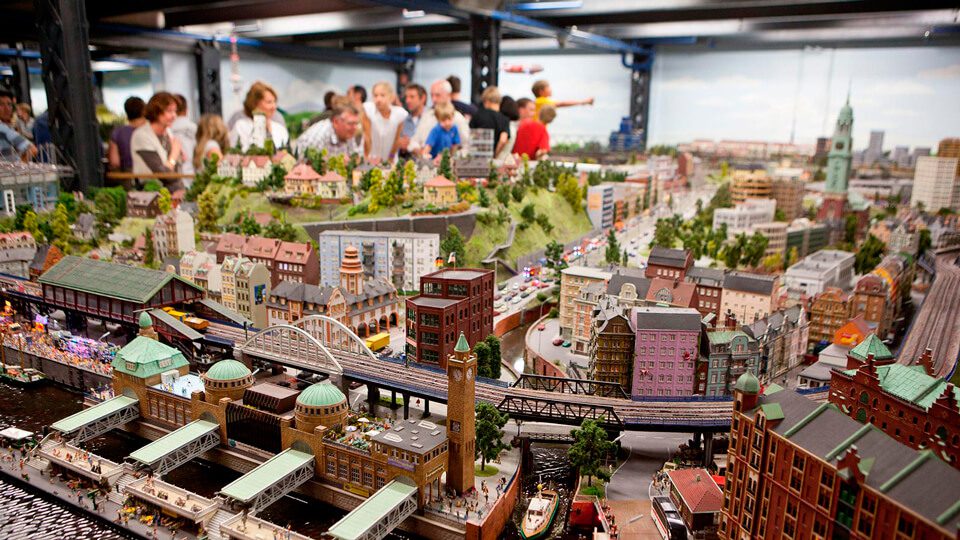
In the center of the Speicherstadt district, imbued with the atmosphere of a bustling harbor, lies a wonderland – a model of the northern railway and its adjacent territories, created in 2000 by Gerrit and Frederik Braun. The twin brothers decided to fulfill their childhood dream and created the largest toy railway in the world. A year later, the miniature museum featured three sections, and by 2010, the model was fully completed. Today, the wonderland includes 15,400 meters of railway tracks, 1,040 trains, 4,340 buildings, and thousands of tiny trees, cars, streetlights, and figurines of people.
Here, everything is real: passenger trains arrive at the railway station, an airplane prepares for takeoff at the airport, residents of the Harz Mountains climb to the top of the Brocken, and football players score another goal at the “Imtech Arena” stadium. Visitors to the mini-world can see not only the lands of Germany but also Scandinavia, Switzerland, America, Austria, and Italy.
The museum is located at Kehrwieder 2 and is open daily from 9:30 AM to 7:00 PM.
Elbphilharmonie and Free Viewing Platform
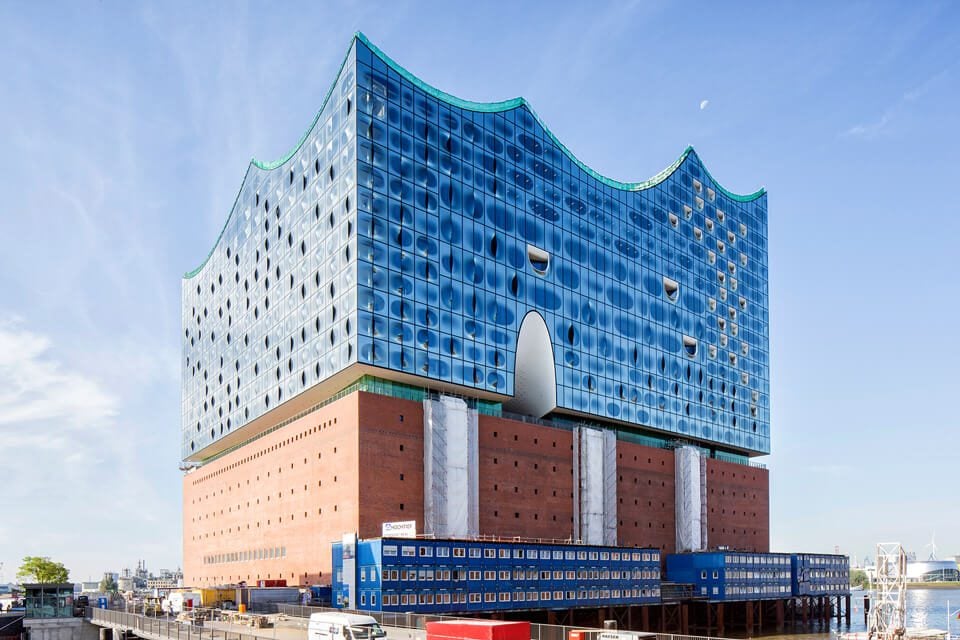
In January 2017, after a long 13-year wait, the Elbphilharmonie opened in the HafenCity district. The construction of the 26-story building with a total area of 21,800 square meters cost 789 million euros. The new cultural landmark resembles an exotic sail. On the brick base, which previously served as a warehouse, rises a glass structure made of 1,000 panels. The curved shape and sun-protective coating ensure a comfortable atmosphere inside the building.
The musical complex includes three concert halls. Their walls are covered with consoles, each consisting of a million cells that absorb and diffuse sound waves. The main hall is designed according to the vineyard principle: the audience seats are arranged so that each visitor is no more than 30 meters away from the orchestra. The philharmonic also houses residential apartments and a hotel. At a height of 37 meters is a circular observation deck, which you can access for free.
Address: Platz der Deutschen Einheit 1.
Dockland and Free Viewing Platform
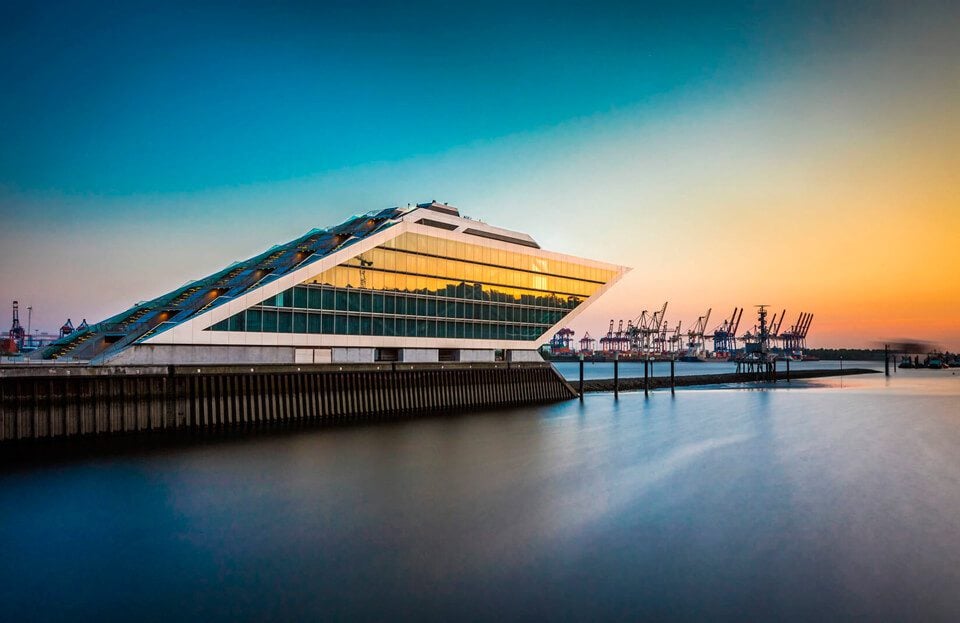
Dockland (Dockland) rises above the Elbe like the bow of an ultra-modern ship – the most unusual building in the city, in the shape of a parallelogram, which appeared in 2006 at Van-der-Smissen-Str. 9. The six-story building with a double glass facade, supported by a steel frame structure, has an area of 7,000 square meters used for office spaces.
Two panoramic elevators connect the floors of Dockland, built on a pier in the middle of the water. The roof of the building is accessed by 136 steps with a 60° slope. Those who conquer them are rewarded with an impressive view of the harbor from the viewing platform at a height of 47 meters.
Botanical Garden
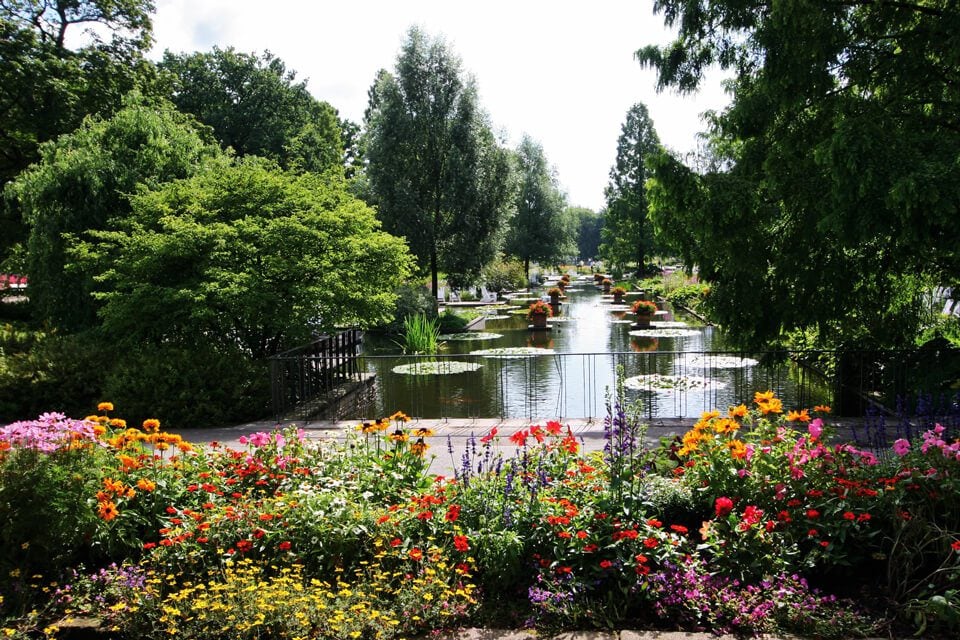
On St. Petersburger Straße 28, a few minutes’ walk from the S-Bahn Hamburg Dammtor station, the botanical garden sprawls like a green forest adorned with exotic plants and flowers. The natural oasis was established in 1821 by botanist Johann Lehmann. For a long time, the area was privately owned by its creator but eventually passed into the city’s possession and became a public place. The garden’s core consists of five greenhouses representing a collection of tropical plants and succulents.
The botanical garden offers its guests not only a walk through the 24-hectare park area. Hamburg’s green lungs provide the opportunity to travel the world for free and get acquainted with diverse landscapes and flora from around the planet: see plants from the Balkans, Carpathians, and Alps, visit a corner of China and Japan, and admire the Biblical Garden of Jerusalem.
Hamburg City Hall
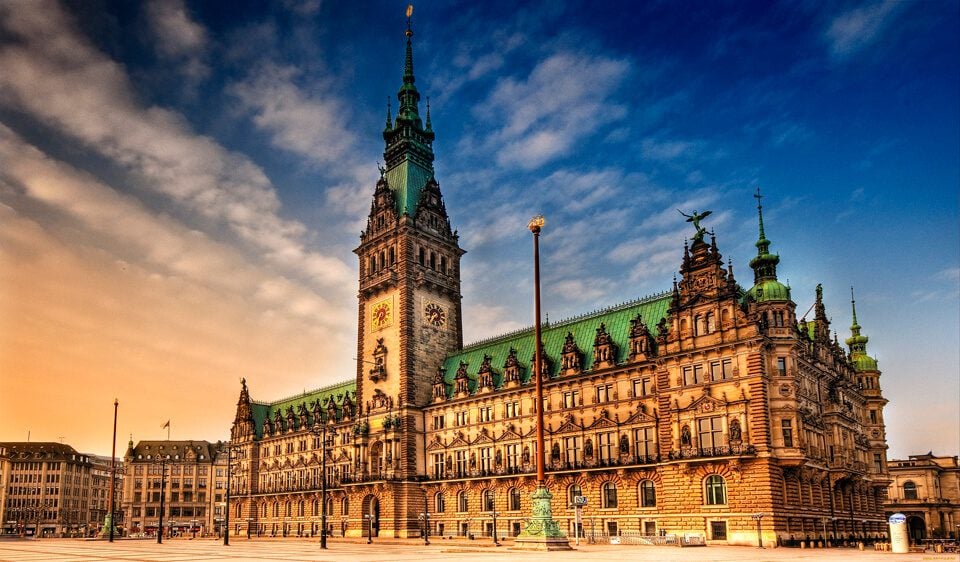
In the city’s center stands the city hall, strikingly different from typical Hamburg buildings. The sandstone and granite structure evokes associations with a neo-Renaissance castle. Built between 1886 and 1897, the building is now the residence of the municipal government and city administration. In 1842, a fire destroyed Hamburg’s town hall. The new city hall was opened 55 years later. The niches of the luxurious facade, standing on 4,000 oak piles, are adorned with 20 statues of German emperors.
Above the main gates rises a 112-meter baroque tower topped with a massive spire. Behind the decorative wrought iron gate of the main portal is the entrance to the hall, revealing 16 monumental columns and 68 portraits of famous city citizens. Two Sardinian marble staircases lead to the Senate and Legislative Assembly chambers. The building has a total of 647 rooms, each with unique interiors.
You can explore the attraction as part of a guided tour. Visiting hours: from 11:00 AM to 4:00 PM (Monday to Friday), from 10:00 AM to 5:00 PM (Saturday), and from 10:00 AM to 4:00 PM (Sunday).
Reeperbahn

“Sinful Mile” is what locals call the street in the St. Pauli district leading to the city harbor. This place, known since the 19th century as the heart of Hamburg’s nightlife, attracts lovers of dancing, alcohol, and “adult” entertainment every night. Here you will find sex shops, casinos, restaurants, trendy discos, and the scandalously famous red-light district – legal brothels. The most prominent attractions are the St. Pauli Theater, with its preserved 1841 interiors, the “Rock’n’Roll House” cafe, and the “Indra” nightclub, where the legendary Beatles performed in 1960.
In the morning, when the neon lights go out, Reeperbahn turns into a quiet street. Here you can immerse yourself in the atmosphere of the Hanseatic city, shop, sit in one of the many cafes, and admire wax figure replicas of famous personalities at the Wax Museum.
Elbe Tunnel
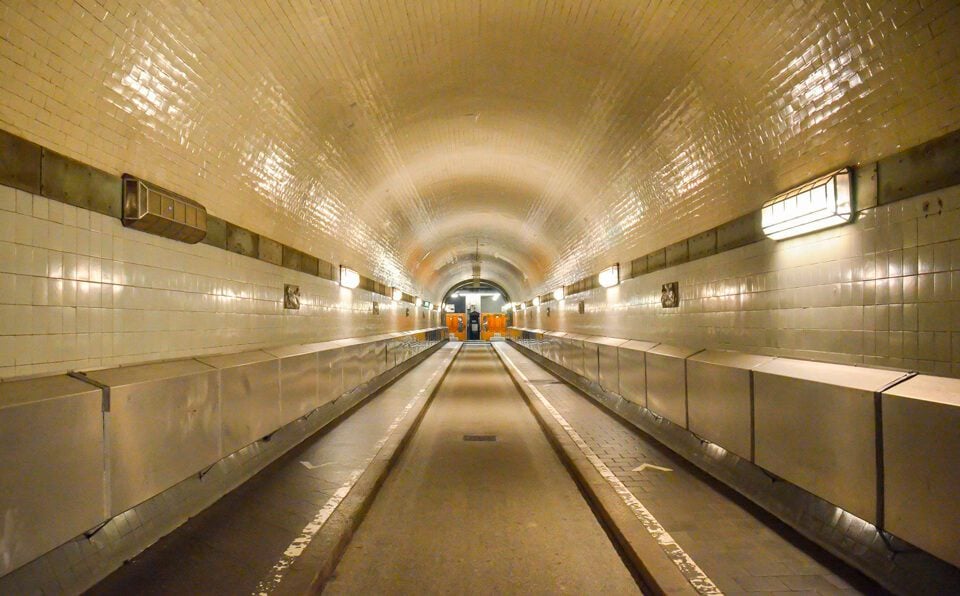
In 1907, the rapid development of the port prompted the construction of a tunnel to ensure communication between the north and south banks of the Elbe. In 1911, the 426-meter-long structure, located 23 meters deep, celebrated its opening. The underground passage was accessible not only to pedestrians – the size of the two tubular constructions allowed horse-drawn carriages to pass through. Though a new modern conduit appeared under the river in 1975, the old tunnel continues to serve a transport function today.
You can enter the structure using elevators or stairs. The walls of the underground corridors are decorated with ceramic tiles, covered with a special film that makes even the slightest water leaks visible. Each year, about 300,000 cars cross the Elbe through the brightly lit galleries. The toll for crossing is €2.50. Cyclists and pedestrians can use the crossing for free.
Alster Lake
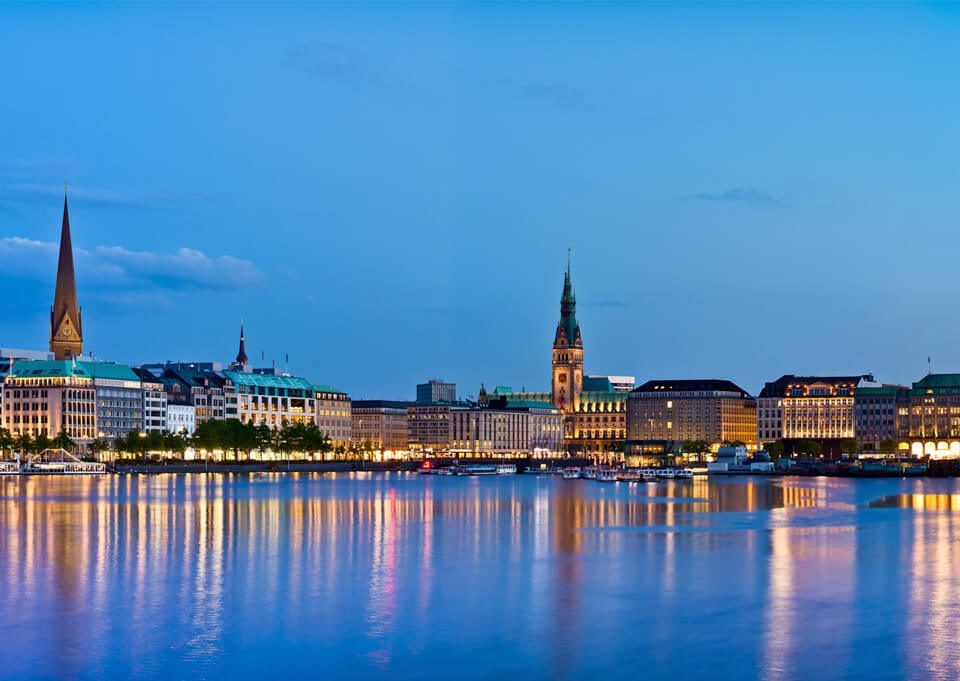
Hamburg, already rich in water arteries, is also famous for its man-made body of water – Alster Lake, located in the city center. The idea of creating a city reservoir belonged to Count Adolf III, under whose orders work began in 1190 to divert one of the Elbe’s tributaries and dam it. The resulting lake consisted of two parts: the Inner Alster, covering 18 hectares, and the Outer Alster, spanning 164 hectares.
The lake’s shore is occupied by a park – a favorite place for residents and tourists to relax. A 7-kilometer trail, popular among fitness enthusiasts, runs through the area. The green zone is especially beautiful in spring during the cherry blossom season. Every April, the Japanese community, which gifted the city with the exotic trees, organizes fireworks. Visitors to the park and the wealthy residents of the luxurious villas along the lakefront can all enjoy the stunning display.
Hagenbeck Zoo
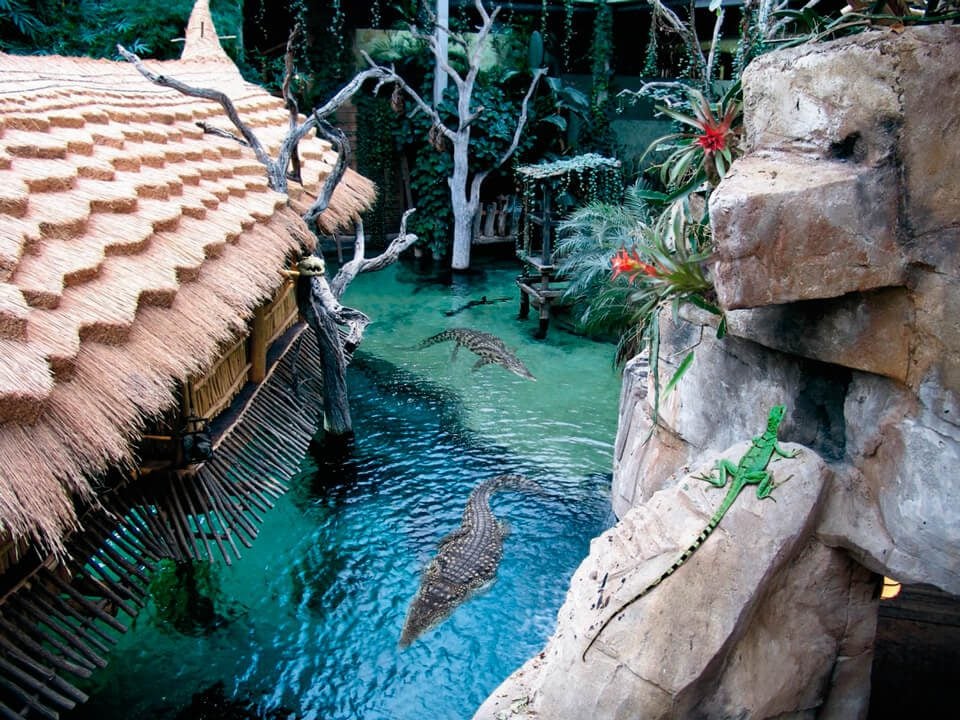
Hagenbeck Zoo (Tierpark Hagenbeck) is not just a zoo. It is an entertainment center and a natural area where fauna inhabitants live freely. In 1907, German businessman, animal trainer, and passionate animal collector Carl Hagenbeck realized his dream by founding a park where four-legged and winged planet inhabitants lived in harmony with their surroundings. The zoo is still owned by Carl’s descendants.
In the 25-hectare area, there are no traditional cages. More than 200 animal species live comfortably in open spaces separated from visitors by water-filled moats. Predators are an exception – they are housed in large enclosures. At the main entrance, visitors are greeted by an 8,000-square-meter tropical aquarium – home to reptiles, amphibians, and ocean dwellers. Additionally, the zoo regularly hosts exciting shows featuring trained animals. A section with tame animals is open for young visitors, accessible by a miniature railway.
Address: Lokstedter Grenzstraße 2. Adult admission is €30, and children’s admission is €21.
Fish Market
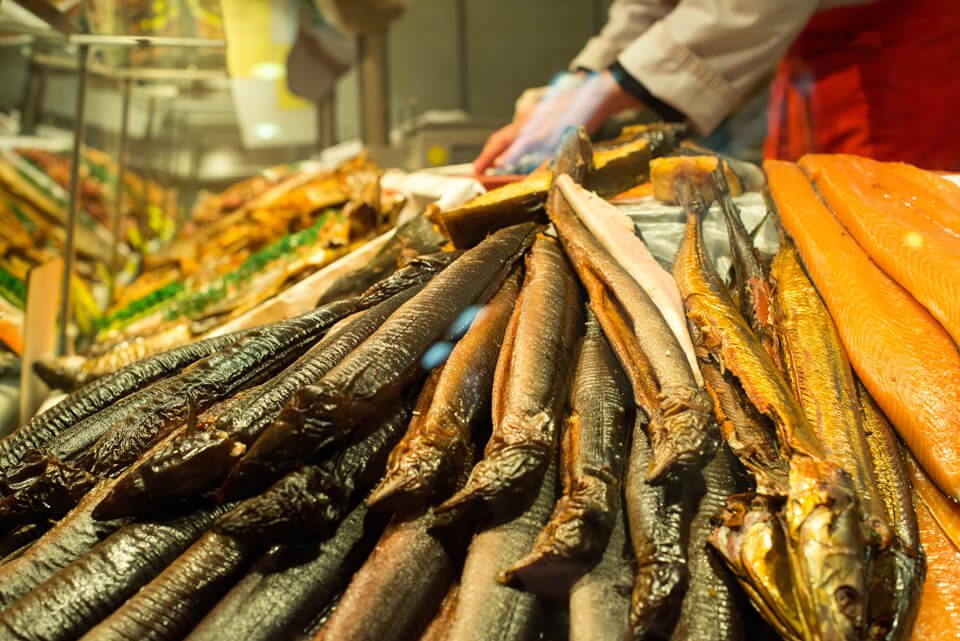
For over 300 years, the traditional market on Große Elbstraße 9 has sold everything the heart desires: fresh fish, seafood, vegetables, fruits, clothing, flowers, and souvenirs. Every Sunday, around 70,000 visitors flock to the vast square by the port’s waters. Residents hurry to shop, while tourists stroll between the stalls, listening to the loud calls and amusing jokes of the vendors. Only here can you taste the northern city’s signature fast food: smoked eel and herring sandwiches.
If you want to visit the market, prepare to get up early. From April to October, trading takes place from 5:00 AM to 9:30 AM, and from November to March from 7:00 AM to 9:30 AM. Another market feature is the adjacent fish auction. Tired night revelers, who have spent the night touring the Reeperbahn’s entertainment venues, gather here for breakfast accompanied by live music.
Tip: After exploring the market, visit the nearby historic Altona district – a former port previously belonging to Denmark.
Bergedorf Castle
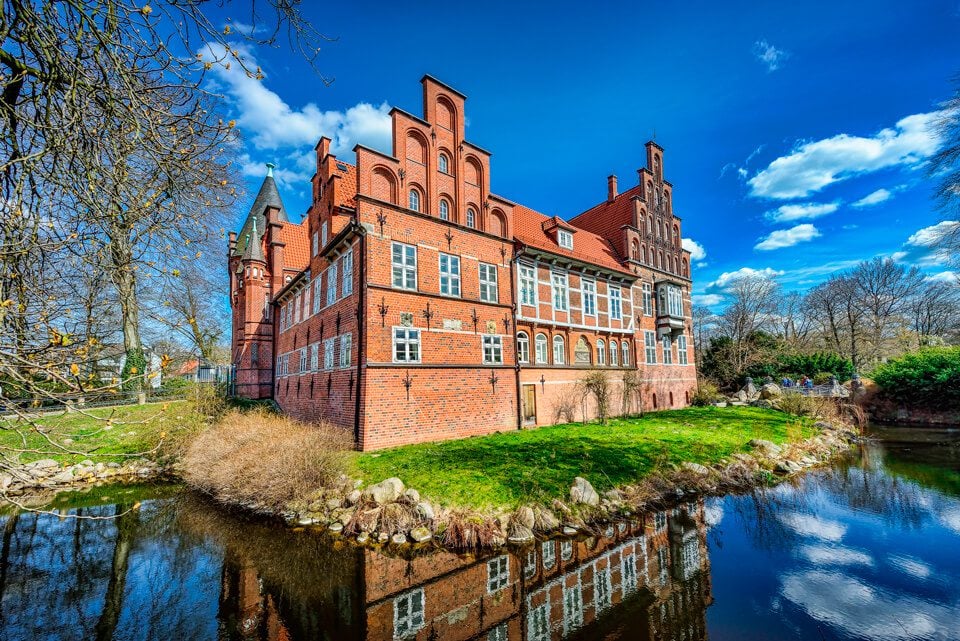
To visit the only surviving castle in Hamburg – Bergedorf Castle (Das Bergedorfer Schloss), you need to leave the city center and head to its outskirts – the Bergedorf area. Here, on a small island formed by the Bille River, lies an architectural monument surrounded by a park and a double protective moat.
The castle is first mentioned in chronicles from the 13th century. It was then a defensive structure protected by a palisade. The building’s current appearance, combining neo-Gothic and half-timbered styles, was achieved in the 16th century: it is a 30 by 30-meter structure featuring massive towers, four wings, and a drawbridge. The history of Bergedorf can be explored in the mountain village museum, which regularly holds exhibitions on the region’s culture.
Address: Bergedorfer Schloßstraße 4. The museum is open from Tuesday to Sunday, 11:00 AM to 5:00 PM.
Hamburg State Opera
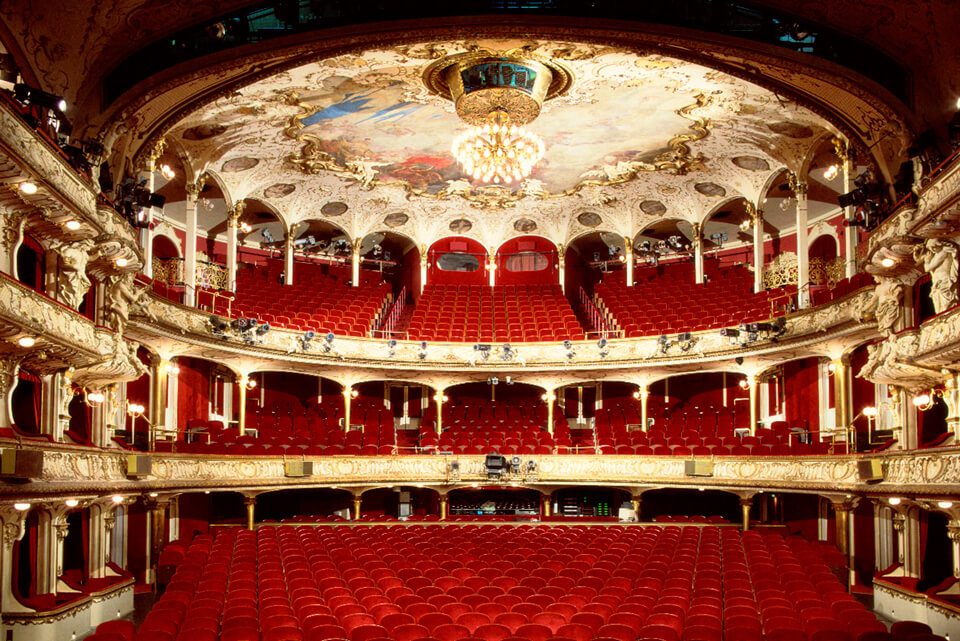
The history of the city’s cultural center, the opera house (Staatsoper), dates back to the mid-17th century. The construction of this temple of Melpomene began at the initiative of wealthy locals who dreamed of a public musical stage in the city. Its opening took place in January 1678 with the premiere of the opera “Adam and Eve.”
Initially, self-taught singers performed on Staatsoper’s wooden stage, and the repertoire depended on the tastes of wealthy citizens, the royal court, and the clergy. A professional troupe and new art forms (comic plays, overtures, dance interludes) appeared in the early 18th century. During World War II, the building was damaged in an air raid and was restored only in 1955. In 2005, a modern structure – a new opera house with an area of 8,500 square meters – was built next to the old building.
Address: Große Theaterstraße 25.
St. Michael’s Church
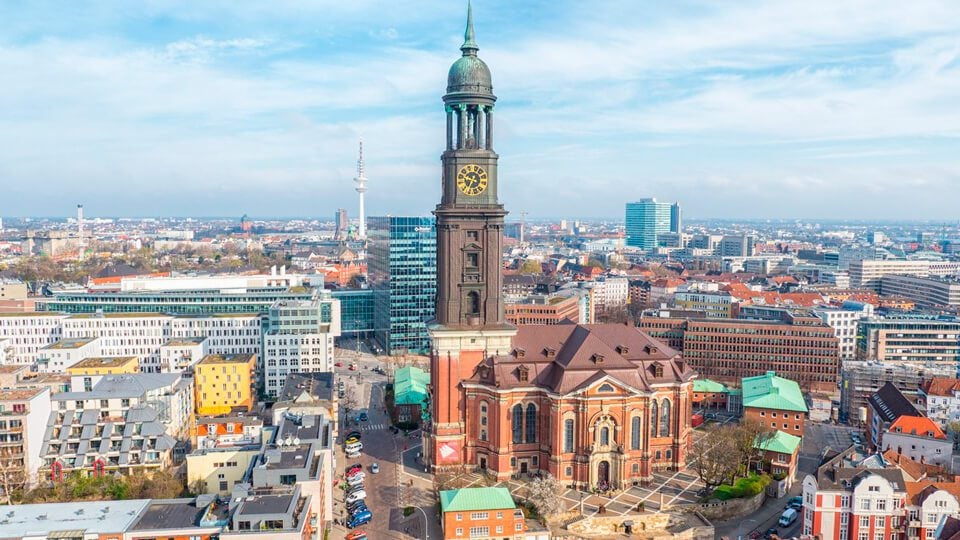
“Big Michel” is what locals call the main Protestant church, a famous landmark, and a symbol of the city. The first Gothic cathedral, built in 1669, was destroyed by lightning. The second church met a similar fate, falling victim to a fire. The modern church appeared on Englische Planke 1 in 1912.
The bell tower with round clocks, rising 132 meters into the sky, is visible from afar. At a height of 110 meters, there is an observation platform accessible by a spiral staircase. The strict lines and black color of the tower blend beautifully with the baroque red-brick church building, decorated with gilded elements, reliefs, and limestone pilasters.
Above the entrance is a bronze statue of Archangel Michael piercing a defeated Satan with a spear. The nave’s height is 27 meters, and its length is 71 meters. The church’s white interior walls are adorned with decorative columns with gilded stucco, paintings with biblical scenes, and four organs. The central element of the interior is a 20-meter marble altar. Beneath the nave, in the church crypt, are buried members of Hamburg’s influential families.
Opening hours: daily from 10:00 AM to 6:00 PM from November to April and from 9:00 AM to 8:00 PM from May to October.
Port of Hamburg

The Hanseatic city’s harbor is Germany’s largest seaport and one of the world’s most high-capacity ports. No wonder the metropolis is called the “Gateway to the World.” Every year, up to 13,000 ships arrive here, and the number is constantly growing. The harbor, over 825 years old, covers an area of 73.99 square kilometers, about one-tenth of Hamburg’s total area. The quay line stretches for 275 kilometers.
The harbor’s history dates back to 1189 when King Frederick I honored the city by granting it the exclusive privilege of levying customs duties on all ships transporting commercial cargo on the Elbe. The port’s development also led to Hamburg’s prosperity. The architectural ensemble of Germany’s maritime gateway evolved over centuries.
Here you will find both Gothic red-brick buildings typical of all Hanseatic League cities and futuristic modern structures.
To get a general idea of the harbor, we recommend taking one of the numerous barge tours. The pier is located at Elbbahnhof, near the Landungsbrücken landing stage. Ticket prices range from 12 to 18 euros.
Planetarium
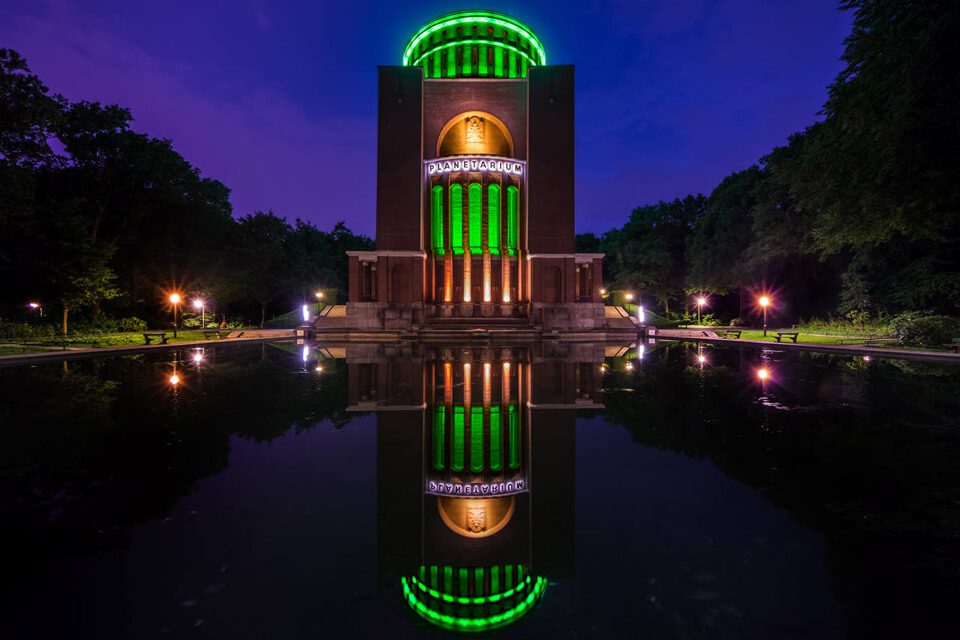
Each year, over 300,000 people embark on a journey through the universe in the “star theater.” The planetarium, housed in a former water tower, opened in the city park in 1930. Today, the building’s facade is adorned with columns illuminated by spotlights at night. The central dome hall, with a 360° view, is 21 meters high and consists of 40 million points (8K resolution).
This is the world’s first planetarium where breathtaking ultra-clear 3D images merge with 3D sound. The starry sky is accurately reproduced by 9 Carl Zeiss laser projectors and 70 mirrors. After the impressive show, visitors can grab a bite at the Nordstern cafe and ascend to the observation deck at a height of 40 meters.
The planetarium is open from 9:00 AM to 5:00 PM (Monday-Tuesday), from 9:00 AM to 9:00 PM (Wednesday-Thursday), from 9:00 AM to 10:00 PM (Friday), from 10:00 AM to 10:00 PM (Saturday), and from 10:00 AM to 8:00 PM (Sunday). Address: Linnering 1.
Hamburger Dom Amusement Park

Three times a year, against the night sky backdrop in the St. Pauli district, a 60-meter Ferris wheel lights up with hundreds of lights, the air fills with the aromas of waffles and roasted almonds, and heralds announce the start of hip-hop dancer competitions. This means it’s time for the Hamburger Dom festival – the famous fair of the northern metropolis.
Hamburg’s Dom is part of the city’s history. The amusement park got its name from merchants, traveling performers, and craftsmen who, in 1337, were granted the right to organize a market under the arches of Mariendom – the first Christian cathedral. In the late 19th century, by city authorities’ order, the fair acquired a new address – Heiligengeistfeld (Field of the Holy Spirit).
Since then, in spring (March), summer (July and August), and autumn (November), the 20-hectare area transforms into an entertainment park for four weeks. Merchants in tents, lined up along the street, offer toys, souvenirs, national craft items, and various sweets. The various attractions – from thrilling roller coasters to children’s swings – provide a dose of adrenaline for both adult and young guests.

